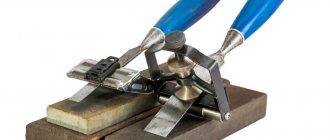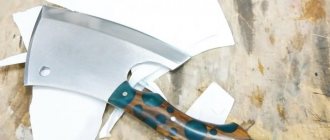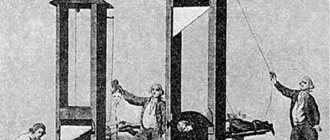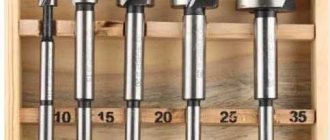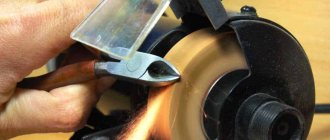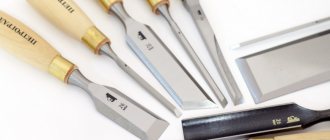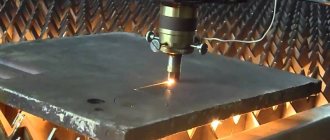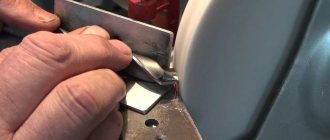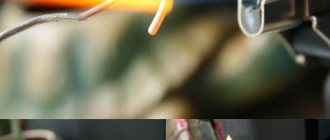Questions about choosing and using a chisel
Chisels of different types
The selection of a chisel should be carried out in accordance with the operations performed with its help and the type of material being processed. The most versatile are metalworking chisels with different sharpening angles of the cutting edge - with their help you can perform a wide range of operations with almost any metal. Moreover, the thicker the metal, the longer and more massive the chisel should be. If, in addition to the usual cutting, it is necessary to make grooves or shaped grooves in metal products, then it is additionally necessary to have a cross-section and a groover.
A good solution would be a chisel with a plastic protector - such a tool is suitable both for training young mechanics and for direct work, it prevents injuries and generally improves work safety.
When selecting chisels for pneumatic and electric tools, you should take into account the type of chuck and the compatibility of chucks of different standards - if you choose the wrong one, the chisel will simply be impossible to install.
The use of a chisel must comply with established plumbing rules and safety requirements. With the correct selection and use of the tool, the desired result will be achieved with minimal time and effort.
Sharpening chisels, angle
Sharpening is performed on a special sharpening machine. The chisel is placed on the tool rest and, pressing slightly, slowly moved along the entire width of the rotating abrasive wheel, alternately sharpening one or the other edge. In this case, the blade should be often immersed in cold water to prevent overheating of the metal, during which it loses the necessary hardness.
After sharpening is completed on the grinding wheel, the burrs are removed from the chisel, and then the cutting edge is threaded on the abrasive wheel.
Hot forging chisel with a sharpening angle of 70-80 degrees
The sharpening angle of the chisel knife for hot cutting is no more than 50 degrees, and for cold cutting - at least 60 degrees.
Finally, the correct sharpening angles of the blade are checked with a special template. As such a template, a metal block is used, in which grooves are cut. The angles in these grooves have the required values, therefore, by inserting a sharpened chisel blade into this groove, you can visually determine the correct sharpening.
Types of chisels - subtle differences
The Kreutzmeisel is used to cut out grooves, which is why it is called a groover, and is a fairly popular type of chisel, but far from the only one. Let's see what else can help us in plumbing work. There are several more varieties of chisels, in addition to the basic metalworker's (the rough one mentioned above) and the cross-cutting chisel (groover), for example, a peak chisel, a blacksmith's chisel, a nibbler and a punch. Perhaps we’ll say a few words about each.
Let's start with the plumbing option, the most primitive and crude. In appearance, this type resembles a metal block, where the angle of the cutting part is sharpened. Manufacturers of metal chisels additionally harden and temper the steel, especially at the tip. Typically, the length of such an instrument is from 10 to 20 cm with a width from 5 to 52 mm. The corners on the blades are sharpened depending on the type and thickness of the metal. The angle can be obtuse if the chisel is intended for cutting soft metal, and vice versa, for hard metals the angle should be sharper. In metalworking chisels, the middle part is made the most convenient shape for holding with your hands while cutting. Such a tool is distinguished by its cross-section; it can be either elliptical or multifaceted
It is important that the edges of the chisels are filed and cleaned. The quality of work and productivity will depend on this. The groover is not actually a crossmeisel, although they are often identified
They are painfully similar, and their task is the same - creating grooves, but it is the groover who can also make them shaped, for example, semicircular, his tip can have different shapes. A blacksmith's chisel is mounted on a long wooden handle. In appearance it resembles a hammer. This design helps to work with hot metals and is well suited for very cold cutting. Often, forging chisels are not only shaped, but also with rounded cutting edges. This type is referred to as overhead forging tools. They differ from metalwork chisels in that the cutting parts are called a knife, and they are sharper. The standard length of such a tool is from 30 to 50 mm. If you need to cut cold metals, you can use chisels with a length of 16 to 19 cm, and for hot metals, a suitable length will be from 18 to 24 cm. It is important that the wooden handle is not wedged, this can affect not only the quality of the work, but also on safety. The chisel pick helps break down the heaviest metals. Its purpose is to equip pneumatic concrete breakers, as well as chippers and jackhammers. The working part is pointed, which allows you to make deep cuts. The nibbling chisel and the undercutting chisel are distinguished by a curved working part. They are used when you need to cut out shaped lines in sheet metal. Often both tools are called sweepers, but this is incorrect. Undercuts resemble upside-down chisels, and their purpose is to speed up the cutting of metal. They are also distinguished by tetrahedral tails, which are inserted into the corresponding grooves on the anvils. Punchers have a cone-shaped working part and are used when it is necessary to punch holes in sheet metal.
Recently, new models of chisels have been released. They are more advanced and easy to use. These are chisels with protectors, caulks and weighted chisels. Options with a tread are among the safest. Thanks to the protection, a secure grip is ensured. The protector also protects your hands from being hit by hammers. Caulking chisels have a very wide working part, so any surface can be processed quickly and efficiently. Such models are widely used when it is necessary to caulk cracks in log houses or remove old ceramic tiles from the walls. Weighted chisels are used when it is necessary to destroy concrete or brick structures. Such instruments are heavy and massive.
Knife sharpening angles: table of degrees for different types
To avoid errors when determining the sharpening angle of knives, it is worth using a ready-made table of degrees for different types of tools.
| Knife type | Sharpening angle in degrees |
| Kitchen household | 30-35 |
| Kitchen professional | 25-30 |
| Chef's professional (chef's knife) | 20-25 |
| Dining room | 55-60 |
| For cutting fish, including fillet knives | 25 |
| For cutting meat | 30 |
| For working with vegetables | 35 |
| For preparing fillets (separating meat from bones) | 25-30 |
| For cutting loin | 10-15 |
| For working with animal products | 30-45 |
| For slicing hard/plate root vegetables | 22-25 |
| Penman | 20-25 |
| Tourist, when blade sharpness is a priority | 30-35 |
| Tourist when high wear resistance is needed | 40-45 |
| For carpentry work | 30-45 |
| Chopping | 45-60 |
| For shoe repair | 30-40 |
| For cutting leather | 20-25 |
| Hunting for sanding | 15-45 |
| For slicing baked goods | 15-22 |
Separately, you will need to determine the sharpening angle of Japanese knives, and this parameter ranges from 15-40 degrees. This is due to the fact that Japanese craftsmen offer knives on the market for various purposes, with one-sided or double-sided sharpening, and slopes of different heights. Truly professional Japanese knives have special markings on the packaging, where you can find recommendations on the sharpening angle of the blade.
Technology of working with impact-cutting tools
Kreutzmeisel is intended for carrying out delicate work, for example, when creating shaped grooves and grooves on various parts. Working with the device involves using a heavy impact device. Typically a machinist's hammer or sledgehammer is used. Its weight should vary from 500 g to 1 kilogram. The workpiece to be worked with is fixed in the required position using a vice. This can be done in any other way. The main thing is to ensure that the part is securely fastened. The tool is held with the left hand at an acute angle relative to the workpiece. With the right hand, strikes with a hammer on the back end of the crossmeisel. They must be precise and short. Do not hold the tool too tightly in your hand. If the master is left-handed, then use the opposite position of the hands - a hammer in the right, a tool in the left.
Safety precautions
Following these simple recommendations will help make working with a cross-section machine safer:
- You should start working with safety glasses. This will protect your eyes from metal fragments getting into them.
- If the workpiece is fragile, it will require installing a protective mesh to your left, i.e. from the side of the hand holding the crossmeisel.
- Before starting work, you should check the tool. The tip of the chisel should not have burrs or cracks. The hammer head must also be clean.
- The workpiece must be securely fixed in the clamping device before starting work.
- During the process, strictly follow the technology of working with a chisel. The hammer blows should be exactly on the back end of the tool. You need to hit short, without swinging.
- Since injuries are almost inevitable during such work, it is recommended to use a special protective “fungus” that is placed on the crosspiece. It is designed in such a way as to protect the hand and at the same time not block the operator’s view.
If the crosspiece was not supplied with a protective rubber washer from the manufacturer, you can make it yourself. A circle with a diameter of approximately 70 mm is cut out of a sheet of rubber approximately 1 cm thick. Two 10 mm holes are drilled in the center of the rubber pancake, and the jumper between them is cut. After this, the protection is ready for use. The washer will cover the brush and will not obstruct the view of the tool.
Kreutzmeisel and chisel [edit | edit code ]
For the most part, the chisel and crossmeisel are very similar. These two tools are made of steel and have a striking part that absorbs the impact of blows with a hammer or sledgehammer. It also has a working part that the worker can hold on to and guide the tool.
Upon closer inspection of both instruments, their main difference becomes obvious. The working part of the crossmeisel is significantly flattened, with the exception of the tip, on which there is a chopping edge.
What is Kreuzmeisel?
What does a crossmeisel look like?
What is the crossmeisel for?
What is the crossmeisel used for?
Kreuzmeisel is a metalworking tool.
The name is made up of two German words - Kreuz (cross) and Meißel (chisel).
Has a lot in common with a chisel. Both are made from steel. When working with them, a sledgehammer or hammer is used, which must be struck from above.
However, upon closer examination, you can notice the difference. In the crossmeisel, the working part is flattened; the cutting edge is narrowed.
In the photo at the top is a crosspiece, at the bottom is a chisel.
The main purpose of the crosspiece is to cut out a groove, recess or narrow grooves in metal parts.
Consists of 3 parts:
- percussion, upper
- medium, designed to hold and guide the tool
- working, lower
A chisel is a percussion-cutting tool designed for chopping or chipping metal and stone. It is a steel rod with double-sided sharpening and a flat butt designed for striking with a hammer. The design of the chisel can position it as a hand tool or as an attachment for mounting in a hammer drill. The cross-section of the rod can be in the shape of a circle, rectangle, oval or polyhedron. To reduce the risk of injury, an expanding mushroom made of rubber or other metal can be installed on the striking part of the tool, providing a more comfortable hammer hit and dampening recoil.
Crossmeissel device
So, it’s time to summarize the information on the design of the crossmeisel. Like other types of chisels, crosspieces consist of three main parts: working, impact and middle. The working part is considered to be the front part of the tool, where, in fact, the cutting edge is located. The opposite end of the crosspiece has a frontal surface for striking with a hammer or other similar tool. The middle part is intended for the master's grip.
The design of metalwork crossbars is described in detail in GOST 7212-74. According to this document, the total length of the device is from 125 to 200 mm. The sharpening angles are indicated as follows: 45º, 60º, 70º. Crosspieces have a wider and thinner working end, which makes it possible to cut grooves and create grooves. They must be made from tool steels U7A and U8A (GOST 1435) and 8ХФ (GOST 5950). Cross-sections must have a protective coating, which can be chrome, zinc, cadmium and oxide.
Download GOST 1435-99
Download GOST 5950-2000
Download GOST 7212-74
Crossmeisel and chisels: how do these tools differ?
They have identical basic elements. Both tools are made of steel and consist of a striking part that absorbs the impact force from the sledgehammer/hammer. The work area is sharpened. Both the chisel and the crosspiece are equipped with a middle, which the worker holds onto. It allows you to direct the device in the desired direction. If you look closely at these instruments, the difference becomes obvious. The working part of the crossmeisel is much more flattened than that of the chisel. The exception is the tip, on which there is a chopping edge. This gives the device some resemblance to a spatula. The metal is processed along the sides. A chisel is a rougher tool. The simplest design of this tool is a metal bar, which is tapered and sharpened at one end. Some specific parameters - length, sharpening angle, as well as material of execution - depend on the specific specialization of the tool. This is true for both the chisel and the crossmeisel.
General operating technology
As we said, crossmeisel is used for operations that require very fine work, for example, creating grooves or shaped grooves on the surface of a part. To work with a crosspiece, you need a percussion instrument. An excellent option is a mechanic's hammer or sledgehammer weighing from 0.5 to 1 kg. The workpiece is first secured in the required position using a vice or, if this is not possible, by another option. The chisel is held with the left hand at an angle of 45 to the workpiece to be finished. With the right hand, they hit its back end with a hammer. Strikes must be short and accurate.
In this case, you do not need to squeeze the crossmeisel very tightly in your hand. For left-handers, opposite hand roles are preferred.
Making metal cutting safe
Before working with a crosspiece or chisel, mark the place on the metal that needs to be cut. Holding the tool vertically, set it to the mark. Even if the element being worked on is small in size, it is better to use a vice so that it does not move from the workplace under impact. Next, supporting the chisel with the cutting part, you need to strike accurately with a plumber's hammer. It is important that the blows are short and accurate, and most importantly - clearly on the back. The hand should not tightly grip the chisel while working; you only need to lightly support the tool. Usually the job doesn't finish the first time. You need to perform several of these techniques.
To protect yourself from metal fragments or the hammer or chisel slipping off the workpiece, you should follow a few simple rules. The hammer handle must have a good grip, the worker himself should wear safety glasses, and if the workpiece is fragile, a protective mesh will also be required. If you don’t have enough experience, it’s better to protect your hands by putting a special shield on them. The tool itself, or rather its tip, should not have cracks or burrs; in fact, the hammer head should be just as clean. For the rest, we would only advise you not to rush and make your strikes clearly and briefly.
Chisels for electric and pneumatic tools
Different types of chisels for power tools
This tool has a design similar to that described above, but with its own characteristics. First of all, such a chisel has a shank for installation in the chuck of a pneumatic or electric tool. Usually these are shanks for standard chucks such as SDS, SDS+ and the like, or shanks of a special profile for installing equipment in pneumatic tools.
According to their purpose, chisels for electric and pneumatic tools are:
- Metalworking workshops;
- Peaks-chisels for working on stone;
- Special chisels - caulking tools, for peeling paintwork, chipping, etc.
Chisels of the first type are similar in characteristics to hand tools; they are used to perform various operations in industry and other sectors.
A pick-chisel is a special tool for crushing natural and artificial stone; it is made in the form of a rod with a pointed part, having a round, triangular, square or more complex symmetrical profile. This shape is necessary for effective penetration of the tool into the material and its destruction. Additionally, the working part can be made in the form of a hard alloy insert, and also have various grooves and protrusions to improve characteristics.
Special chisels can have working parts of different widths and profiles - today there are hundreds of options designed to perform a wide range of operations in construction and many industries.
Chisels for electric and pneumatic tools for the most part do not have a single standard, however, during their manufacture, current domestic and foreign standards for the type of shank for the chuck are observed.
Hand chisel
Modern chisel with protector
This is the most common type of chisel, designed to work with various metals and alloys. The tool can be divided into three types according to design and applicability:
- Actually, a mechanic's chisel;
- Kreuzmeisel;
- Ditcher.
A mechanic's chisel is a steel rod, which is conventionally divided into a working part, a middle part (holder) and a striking part (striking part, head, butt plate). The working part has a symmetrical sharpening at one angle or another, the striking part is convex/spherical (with a large radius of the sphere) for better direction of impact, and the holder can have a different section - flat oval, oval, I-beam and hexagonal. A plastic “fungus” can be placed on the body of the tool - a protector to protect the mechanic’s hand from the blow of a hammer. The total length of the chisel can be 100, 125, 160, 200 and 250 mm.
Types of bench chisels
The most important part of the chisel is its working part. It can be straight (design 1) or conical (design 2) in plan (if you look at it flat), and sharpening is carried out at two angles - the main (main) and auxiliary. The cutting edge of the striking part is sharpened to the main angle; the width of the edge can range from 1.1-4.8 mm depending on the size of the chisel. The cutting edge itself can be blunted or even made flat to protect it from intense wear (this ensures the sharpening angle and the correct shape of the cutting edge are maintained longer).
The main sharpening angle depends on the hardness of the metal/alloy being processed; the following range of angles is acceptable:
- 35° - aluminum and its alloys;
- 45° - copper and its alloys, zinc, brass;
- 60° - steel of low and medium hardness;
- 75° - cast iron, high-hardness steel, hard bronze.
That is, the harder the material being processed, the larger the sharpening angle the tool should have. To increase the strength of the tool, its working part is hardened to a certain length (20-25 mm), which allows the sharpening angle to be returned when worn.
Chisels are made from tool steel of various grades - usually U7, U7A, U8, U8A and U9, as well as 6ХС, 9ХС and others. To work on some alloys and stone, the working part can be made of hard alloys based on tungsten, cobalt, etc. Additionally, the tool may have a zinc or other protective anti-corrosion coating.
A Kreuzmeisel is a type of chisel, but with a narrower cutting part, which is actually a narrow wedge. This tool is designed for making grooves and grooves in metals; it has the same design, sharpening angles and other characteristics as a regular chisel.
A groover is a crosspiece with a shaped cutting part; it can be used to make grooves with different profiles. The most common groovers are for making grooves of semicircular, dihedral, rectangular and other sections.
Bench chisels of various types are manufactured in accordance with GOST 7211-86, GOST 7212-74 and some others.
Similar types of tools
The tools that are often united under the general name “chisel” include several devices of different design and purpose. In addition to the chisel itself and the crosspiece already mentioned in the previous paragraph of the article, this includes a center punch and a boletus.
Putting them together, and taking into account the specializations of the tools, we can get the following specification:
Bench chisel. Basic hand-chopping tool for processing metal products. Its length ranges from 10 to 20 cm, width – from 5 to 52 mm. The sharpening angle of the working edge varies from 35 to 75º, the determining factor being the softness of the metal the tool is designed to work with. The dependence is as follows: the less hard the material to be processed, the more acute the angle at the working end of the chisel will be. All chisels can be made from a single piece of steel or with inclusions of carbide components, for processing harder metals and extending service life. The steel, especially in the working area of the chisel, is additionally hardened. Blacksmith chisel. This type has a long wooden handle. As you can guess from the name, it is used when processing hot parts and refers to overhead forging tools. This one looks like a hammer. There are different types of blades; tools with shaped and rounded edges are often found. The length is longer than that of a regular locksmith, sometimes up to 50 cm
When working, it is important that the device is in good working order; the wooden handle should not be wedged. The pick-chisel is designed to work with the hardest metals and stone materials. They are equipped with jackhammers and pneumatic concrete breakers
The working end can be either conical or tetrahedral. The opposite side is optimized for use with power tools. The chisel has a curved working end. It is used when it is necessary to carve a shaped groove in sheet metal. A nibbler chisel is often referred to as a cutting chisel. Undercuts are used to speed up cutting. Instead of the striking end, the hooks have a groove with which they are fixed to the anvil. During the chopping process, pressure on the part occurs from two sides, from above from the chisel side and from below from the undercutting side. A punch (punch) is used to punch holes in steel sheets. The shape of the working part is cylindrical. A center punch is needed to make center marks for subsequent drilling of holes and other markings on parts. It is a steel rod with a pointed end. In addition to simple standard punches, self-propelled punches with a spring mechanism are used in production, allowing marking to be made with one hand without the use of a hammer. Kreuzmeisel. With its help, grooves are cut into the metal, grooves and recesses are cut. Based on the shape of the working end, there are rectangular, round and special cross-cuts. All types of this tool have a narrowed working part to perform their functions. The metalworker's cross-section is made from tool steels U7A and U8A with subsequent hardening.
Shapes and sharpening angles
Hand hammer:
Depending on the purpose of the knife, there are several blade cross-section shapes:
- Scandinavian, when the descent connects the butt with the RK and the cross-section has a wedge-shaped shape. A small angle is convenient for cutting, but does not withstand impact loads well.
- Scandi - the RK angle is more obtuse than in the first case. It withstands shock loads better, but cuts worse.
- Razor, when the slopes have a concave shape, which provides a small angle for the cutting edge and ensures high cutting quality. This sharpening is used for straight razors. It is not recommended to subject the blade to shock loads.
- Lenticular - the descents are curved, while the angle of the RK is of greater importance. This cross-section is typical for axes intended for chopping.
- One-sided - the descent is designed on only one side of the blade. This type is typical for carpentry tools and knives made in Japan.
- European - a wedge-shaped descent from the end turns into a micro-approach at the edge. This cross-sectional shape of the blade provides an increased angle compared to the Scandinavian cross-sectional shape, due to which the blade better tolerates shock loads, allowing chopping movements.
Electric knife sharpener.
Table of values for different knives
A table is used to determine the optimal sharpening angle.
| Knife type | RK sharpening angle in degrees |
| Kitchen | 55-60 |
| Chef | 25-30 |
| For fish | 25 |
| For fillet meat | 10-15 |
| For cutting and deboning | 25-30 |
| For frozen fish and meat products | 35-45 |
| Vegetable | 35 |
| Japanese | 15-18 |
| Special | 40 |
| Folding | 20-25 |
| Tourist for cutting | 30-35 |
| Tourist for cutting | 40-45 |
| Hunting | 40-45 |
| For cutting | 25-30 |
| Shoe | 30-40 |
| For cutting | 20-25 |
| Straight razor | 10-15 |
Equipment and tools used
This list depends on the method of work. Manual cutting is carried out using:
- cutting tools (chisels, crosspieces, etc.);
- a plumber's hammer (chosen by weight and handle length);
- vice;
- metal substrate;
- marking tool.
A metalworking chisel structurally consists of three main parts: impact, middle (holder) and cutting (working). The shape of the cutting part is different for each and depends on the task being solved. A chisel is used to perform a standard chopping operation. Kreuzmeisel has a narrower cutting edge. The groover is designed for cutting grooves, so its cutting part is made in the shape of a semicircle. The beard is made from a round metal rod, and has a working part in the shape of a circle sharpened around the perimeter. It is used to cut holes in sheet metal. All percussion instruments are made from durable tool steel.
The main parameters of these tools are geometric dimensions and sharpening angles of the cutting part. A plumber's hammer is used to strike the upper (impact) part of the chisel. They differ in the shape of the striker (round or square), the method of attaching the handle, and the total weight.
Cutting out small parts, holes, and individual parts is done using fastening equipment or on steel substrates. To ensure secure fastening, this operation is performed in a vice.
Various metalwork rulers, squares, marking calipers, and small markers are used as marking tools. To make marks, the following are used: cores (of various modifications), scribers with different tip shapes, and pencils. The tools used are manufactured according to developed standards
In industrial enterprises, the tools for cutting metal are special machines. These include:
- guillotines;
- presses (hydraulic and mechanical);
- press shears;
- angle cutting machines.
They have high productivity and allow you to cut even very thick metal.
The hydraulic guillotine is controlled by an electronic unit. With its help, the parameters of the future operation are set. Set the type of metal, the cutting angle, the amount of pressure on the knife, and the cutting speed. In addition to the guillotine, so-called combined units are used to solve these problems. These include cutting machines (press shears) and highly specialized ones (angle notching machines, presses and dies). Press shears are used for cutting sheets and strips of metal, shaped and long products. They work well with profile metal, for example, channel, I-roll, square. With their help, smooth holes and grooves of various shapes are obtained.
Angle notching machines allow angular cutting of metal products of almost any thickness. High precision cutting is achieved thanks to the presence of a scale that allows you to accurately lower the tool to the required place and a correctly sharpened set of chisels.
Presses and stamps solve similar problems. They use mechanical, hydraulic, pneumatic and electric drives.
Terms of use
Before starting work, the chisel is sharpened. This is done on an emery wheel. The sharpening angle should be 20-25 degrees. The sharpening itself should be as smooth as possible, the cutting edge should not have any distortions, even a slight distortion of 3-4 degrees will affect the final result and the quality of the workpiece.
Working with a chisel is not difficult; a little training is enough to learn how to use it correctly. The process is carried out as follows:
- The workpiece is marked with a pencil and securely fastened;
- The blade is placed along the marked line so that the rod has a vertical position;
- The first blow of the mallet on the handle should be light - with its help, a small indentation is made.
- The second blow is applied harder - the tip should enter the workpiece 4-5 mm.
- After that, it is removed from the array and installed nearby. The next blow is delivered. The process is repeated.
- After a closed contour is formed, the top layer of wood 3-5 mm is removed using a chisel.
- The remaining layers are removed using a different method - here it is placed at an angle of 30-45 degrees to the horizontal surface and the wood is removed along the grain. With light blows the wood is hollowed out from the solid wood.
Security measures
The first rule of safe work requires that the blade be well sharpened. If you use a blunt tool, there is a danger of injuring yourself by applying excessive force in the work.
The second rule requires that the workpiece itself be correctly fixed when working. Rigid fixation will ensure high quality work and no injuries.
The third rule is that the rod and handle itself should not have chips, cracks or burrs. The handle must have a ring.
Knowing about these properties of the tool, in the future it will be easy to master the techniques of working with it and make the correct selection of the chisel by type and size.
Types of knife sharpening: single-sided, double-sided, wedge-shaped, asymmetrical
Blade for hammer drill
Self-sharpening knives can be done in several ways, and the choice depends on the type of blade:
- One-sided. It is characterized by sharpening only one side of the blade, the other remains flat, which makes it possible to obtain a perfectly sharp edge. Most often, one-sided sharpening is used for kitchen, household/professional knives, and hunting (skinning) knives. Since it is almost impossible to perform this type of sharpening on a concave blade, it is used only for working with straight blades and bevels.
- Bilateral asymmetrical. It is performed in such a way that the width of one and the other side of the cutting edges are different. This method makes it possible to cut even very hard products and materials into even pieces of different sizes without any effort.
Double-sided sharpening is most often found in Japanese knives, which is why professionals work with them: human safety is ensured by existing skills, otherwise sharpening both edges leads to injuries when working with products.
Wedge-shaped. The most popular type of sharpening, which is characterized by smooth, gentle slopes. Suitable for kitchen, travel, folding and hunting knives. This treatment of the blades allows some types of tools to be used as a lever in field conditions - for example, for lifting fallen thin trees.
Wedge-shaped knife sharpening
